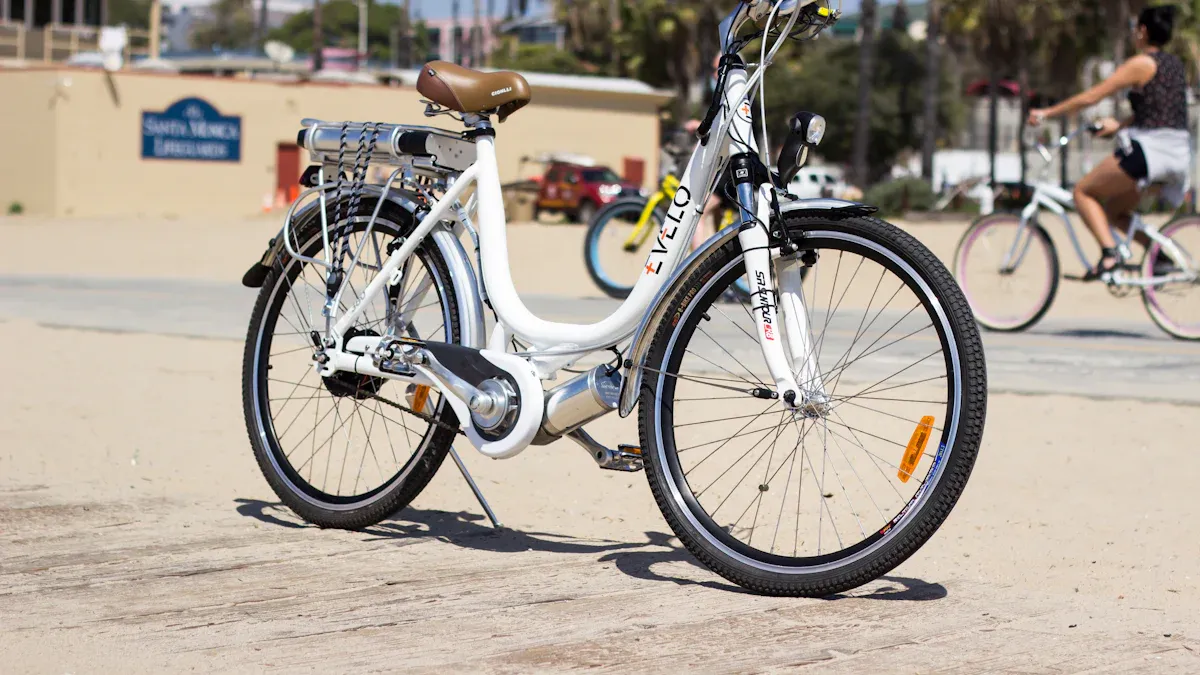
The bike frame weight comparison is crucial for understanding how well a bike will perform. A lighter frame significantly improves speed and hill climbing ability, allowing riders to excel on various terrains. On modern road bikes, the frame and fork typically account for about 18% of the total bike weight, highlighting the importance of selecting the right frame. Factors such as materials, design, and manufacturing processes greatly influence bike frame weight. Being aware of these aspects helps cyclists make informed decisions when choosing the best bike for their needs.
Key Takeaways
Picking the right bike frame material changes weight, strength, and comfort. Carbon fiber is the lightest. Steel gives the most comfort.
The design of the bike frame, like its shape and angles, affects how it handles, stays stable, and moves through the air. This helps balance speed and control.
How the frame is made, like welding and molding, affects its weight and how long it lasts. New methods make frames lighter and stronger.
Lighter bike frames help with climbing, speeding up, and handling. But comfort relies more on the bike’s design and how well it fits the rider than just weight.
Cyclists should choose their frame based on their riding style, the terrain, and their goals. This helps them have better performance and a more comfortable ride.
Materials

Aluminum
Aluminum bike frames are popular because they are light and cheap. They usually weigh between 2.5 to 3.5 pounds (1.1 to 1.6 kg) for a medium frame. This makes aluminum a good choice for casual riders and commuters. The most common aluminum types used in bike frames are 6061 and 7005. These types balance strength and weight well.
Tip: Aluminum frames can last a long time for average riders. However, they do not have a true fatigue limit. This means they might fail after repeated stress. Steel or titanium frames can handle more load cycles without breaking.
Carbon Fiber Bike Frames
Carbon fiber bike frames are the lightest option available. They can weigh as little as 1.3 pounds (0.6 kg) for high-end models. The average weight for carbon fiber frames is between 2 to 2.5 pounds (0.9 to 1.1 kg). This material has great stiffness-to-weight ratios, making it perfect for racing and performance bikes.
Material | Average Weight Range (lbs) | Notes |
|---|---|---|
Carbon Fiber | ~2 – 2.5 | Lightest frames; high-end carbon frames can be around 2 lbs. |
Aluminum | 3 – 4 | Mid-weight range; varies by alloy and finish. |
Steel | 3 – 5 | Wide range; high tensile steel frames heavier (~9-10 lbs), modern alloys lighter (3-4 lbs). |
Titanium | 3 – 4 | Similar to aluminum; offers a balance of lightness and durability. |
However, carbon fiber frames are more expensive. They often cost 30% to over 100% more than aluminum frames. This price reflects the costly materials and hard manufacturing processes. Many cyclists find the weight savings helpful for speed and handling.
Steel
Steel bike frames have been used in cycling for many years. They are known for being strong and comfortable, usually weighing between 3 to 5 pounds (1.4 to 2.3 kg). Steel frames can absorb road bumps better than aluminum or carbon, giving a smoother ride.
Note: While steel is heavier, it is also tougher against damage, like dents and scratches. High-quality steel frames can last a lifetime with good care.
Titanium
Titanium bike frames combine lightness and strength. They usually weigh between 3 to 4 pounds (1.4 to 1.8 kg), making them lighter than steel but similar to aluminum. Titanium resists rust, so it does not need protective coatings like steel.
Titanium frames can last a lifetime if cared for properly.
They can develop weld cracks if not made well, due to titanium’s sensitivity at weld points.
The main downside is the high cost, which comes from the expensive raw material and special welding techniques needed.
Design Considerations

Geometry
The geometry of a bike frame is very important. It affects the bike’s weight and how it handles. Key parts like the head tube angle, seat tube angle, and wheelbase change stability and responsiveness. For example, a bike with a steeper head tube angle is more responsive. This makes it easier to turn. On the other hand, a slacker angle gives a more stable ride but can feel slow.
Head Tube Angle: A 73° head tube angle is more responsive than a 72° or 71° angle.
Front-Center Length: A longer front-center makes the bike more stable. But it can also make steering harder, especially with deep wheels.
Weight Distribution: Good weight distribution is key for handling. Tri bikes usually have more weight in the front. This helps with stability at high speeds.
Small changes in geometry can make a big difference in how a bike handles. Designers need to balance these factors to get the best performance for riders.
Tube Shapes
The shape of bike frame tubes affects aerodynamics and weight. Engineers use tools like Computational Fluid Dynamics (CFD) and wind tunnel tests to improve tube shapes. Aerodynamic tubes are long and narrow. This helps reduce drag and increase speed. However, these shapes can sometimes make the bike heavier. So, there are trade-offs between aerodynamics and weight.
For example, the Colnago V4Rs bike has a longer, stretched frame with narrower parts. This design helps with aerodynamics but might add some weight. The choice of tube shape impacts the bike’s speed and its stiffness and flexibility. A well-designed frame balances these features for the best performance without losing durability.
Manufacturing Techniques
Welding Methods
Welding methods are very important in making bike frames. Different techniques change both weight and how well the bike performs. Common welding methods are TIG (Tungsten Inert Gas) and MIG (Metal Inert Gas).
TIG Welding: This method makes strong and clean welds. It allows for careful control, which helps cut down on extra material. This makes frames lighter without losing strength.
MIG Welding: This technique is quicker and often used for making many bikes at once. While it may not be as clean as TIG, it still makes strong joints. However, the extra material can make the bike a bit heavier.
Tip: Picking the right welding method can boost the bike’s overall performance. A well-welded frame can help with handling and last longer.
Molding Processes
Molding processes greatly affect the weight of bike frames, especially carbon fiber ones. These processes let manufacturers create shapes that metal frames can’t easily have.
Carbon fiber frames are made by stacking thin carbon fiber sheets soaked in resin. This method allows for careful design of strength, stiffness, and weight.
The molding process lets manufacturers create complex shapes and different thicknesses. This strengthens high-stress areas while using less material in low-stress spots.
Carbon fiber is very strong for its weight, making frames 20-30% lighter than similar aluminum frames while keeping or improving strength.
Removing metal joints and lugs through molding cuts down weight and helps spread stress better.
Customizing how the fibers are arranged allows frames to be stiff sideways for power and flexible up and down for comfort. This mix is hard to get with metal frames.
New manufacturing techniques like hydroforming and 3D printing also improve bike frame design. These methods help create better shapes that boost aerodynamics and strength. They let manufacturers control frame geometry closely, improving stiffness and comfort. Using advanced materials with these methods leads to lighter and stronger frames that enhance performance and durability.
Weight vs. Performance
Strength-to-Weight Ratio
The strength-to-weight ratio is very important when looking at bike frames. This ratio shows how strong a material is compared to its weight. Different materials have different strengths:
Carbon Fiber: This material has the best strength-to-weight ratio. It helps make very strong and light bikes. The fibers in carbon fiber can be arranged in different ways to improve performance.
Titanium: This material is very strong and is about 40% lighter than steel. It is durable and resists wear, making it a great choice for high-performance bikes.
Aluminum: Aluminum is lighter than steel but usually not as strong or stiff as titanium and carbon fiber. Still, it offers a good mix of weight and durability for many riders.
Steel: Steel frames are strong and last a long time, but they are heavier than aluminum and titanium. They can be made to flex, which makes rides more comfortable, but they are not as light as other materials.
Material | Strength-to-Weight Characteristics | Density Relation | Stiffness and Design Notes |
|---|---|---|---|
Carbon Fiber | Best strength-to-weight ratio; fibers are very strong and stiff; strength can be arranged in different ways. | Very low density; lightest frame material. | Can be shaped and adjusted; great fatigue strength; failure can be serious. |
Aluminum | 12% stiffer and 20% lighter than steel; not as strong and stiff as steel and titanium. | About one-third the density of steel. | Bigger tubes increase stiffness; risk of ‘beer can’ effect if walls too thin; affordable and light. |
Steel | Strong and stiff; allows thinner tubes for lighter frames; resists wear. | Higher density than aluminum and titanium. | Can be made to flex; easy and cheap to fix; recent strong steels match titanium strength-to-weight. |
Titanium | Half as dense as steel; as strong as most steels; very resistant to rust. | About half the density of steel. | Larger tubes than steel but smaller than aluminum; good fatigue strength; flexible and durable. |
Handling and Stability
Weight affects how a bike handles and its stability. Lighter bikes usually improve handling and speed. This can make riding more fun. However, the link between weight and stability is tricky. Heavier bikes may feel stiffer and less quick, while lighter bikes can speed up better and feel more nimble.
Weight Distribution: Stability depends on weight and how it is spread out on the bike. A balanced bike can feel stable even if it is light.
Frame Geometry: Certain geometry features affect handling and stability:
Slacker head tube angles make the bike more stable by stretching the front-to-center distance. This design helps the bike go straight but can slow down quick turns.
Shorter chainstays bring the back wheel closer to the rider’s weight, improving balance and aerodynamics.
Lower bottom bracket drop lowers the center of gravity, making the bike more stable but reducing cornering space.
These geometry and weight distribution factors, along with reducing frame weight, help create a bike that feels stable and gives confidence in different cycling situations. For many riders, the difference in handling between a well-made lighter bike and a heavier, poorly made one is big. However, after a certain point, the rider’s skill and the terrain matter more.
In professional cycling, rules like those from the Union Cycliste Internationale (UCI) set a minimum bike weight of 6.8 kilograms (14.99 pounds). This rule keeps bikes safe and strong, stopping them from being too light. While lighter frames can be made, cutting weight too much is limited by safety, durability, and ride quality concerns.
Bike Frame Weight Comparison
Climbing and Acceleration
Comparing bike frame weight is very important for climbing and acceleration. Lighter frames have big benefits in these areas. Here are some key points to think about:
Heavier bikes make it harder to pedal, especially uphill.
Light bike frames help riders climb about 10% faster with the same effort.
Using a lighter bike can save about 12.5% more energy on steep hills compared to a heavier one.
Lighter frames help with faster acceleration, allowing quicker speed increases. This is especially helpful in races or when changing positions quickly.
The impact of heavier rims on acceleration is not as big as many think. It mainly matters when speeding up and is less important during steady riding.
Lighter frames help lighter riders more because of better power-to-weight ratios.
In races or on steep hills, lightweight frames have clear benefits. But for many riders, getting fitter and improving skills might be more important than having a lighter frame.
Rider Comfort
Rider comfort is another key factor affected by bike frame weight. While lighter bikes often feel quicker and more responsive, this doesn’t always mean they are more comfortable on long rides. Consider these points:
Heavier bikes, like sport touring or randonneuring models, usually focus on comfort, stability, and durability. These are important for long rides.
The weight difference between bikes, like 17 to 25 pounds, usually matters less for comfort than bike geometry and stable handling.
Some riders say that heavier bikes feel more comfortable and natural, even if they are slower or less quick.
Comfort on long rides depends more on bike design and handling than just frame weight.
Things like rider fitness, riding style, gear weight, and bike fit affect comfort more than frame weight does.
Choosing the right bike frame means knowing some important factors. The material you pick affects weight, strength, and comfort. For example, carbon fiber is very light, while steel is strong and comfy for long rides.
When picking a frame, cyclists should think about how they ride and what they need. Lighter frames are better for racing, while heavier ones work well for touring. Also, the type of terrain and weather can affect which materials are best.
In the end, cyclists should focus on their own needs and likes. Making a smart choice leads to a better riding experience.
Frame Material | Weight Characteristics | Durability & Repairability | Comfort & Riding Style Suitability |
|---|---|---|---|
Carbon Fiber | Very lightweight; stiffer and stronger than steel | Hard to fix; not cheap | Very comfy; great for racing |
Steel | Heavier than aluminum; strong and durable | Can be fixed; may rust | Very comfy; good for touring |
Lighter than steel; strong | Hard to fix; very durable | Very comfy; smooth ride | |
Aluminum | Light but heavier than carbon fiber | Harder to fix than steel | Stiff and comfy; good for climbing |
FAQ
What is the best bike frame weight for racing?
The best bike frame weight for racing is usually between 2 to 3 pounds. Lighter frames help racers go faster and climb better on different surfaces.
How does frame material affect comfort?
The material of the frame really affects comfort. Steel frames soak up road bumps well, giving a smoother ride. On the other hand, carbon fiber frames are stiff. This can help with performance but might make you feel more of the road.
Can I change my bike frame later?
Yes, you can change your bike frame later. Riders can pick a lighter or better frame that fits their needs. Just make sure it works with your current parts like wheels and brakes.
How does bike frame weight affect handling?
Bike frame weight affects how the bike handles by changing stability and quickness. Lighter frames are usually more nimble, while heavier frames can be more stable, especially when going fast.
What should I think about when picking a bike frame?
When picking a bike frame, think about the material, weight, shape, and how you plan to use it. Each part affects how the bike performs, feels, and lasts, so choose a frame that matches your riding style and goals.
